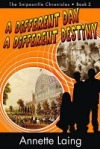Is anything more humbling for a historian than to write historical fiction?
Setting out to write A Different Day, A Different Destiny, the second volume in The Snipesville Chronicles series about three time-traveling kids, I thought I had the history angle pretty well covered. After all, I have a PhD in early American and modern British history, and a historian’s keen sense of when it’s a good idea to look things up. Plus, this wasn’t my first try: In fact, writing Don’t Know Where, Don’t Know When, the first volume in the series, had seemed like cake, because it was so familiar to me. Having grown up in Britain, surrounded by the World War II generation whose presence made me feel sometimes that “The War” had never ended, it wasn’t much of a stretch to picture my modern American kids in England in 1940.
When I decided that, for their second adventure, the kids would head to 1851, I was confident: The Victorians fascinate me, and I’ve read plenty about them. Or, at least, I thought I had.
But it’s amazing, really, what stuff that trips you up.
Planning to set part of my book at a cotton mill in New Lanark, Scotland, I not only read about my subject, but actually spent a couple of days in New Lanark—I even stayed in a youth hostel housed in former millworkers’ housing. I looked for usable details: At the wonderful museum in the former factory, for example, I asked for and got demonstrations of how exactly the spinning machines worked, and how spinners “pieced” together broken threads of cotton.
When I sat down in Georgia to write about New Lanark, however, I was thrown for a loop by something altogether more mundane than the finer points of spinning: Where would my time-traveling kid Hannah go to the bathroom in the middle of the night, I wondered? Uh-oh. The New Lanark museum doesn’t interpret bathrooms of any kind for the 1850s, and the history of the factory didn’t help much. I guess I could have made up something. But it bothered me to do so, even when we’re talking about fiction. Now I’m not alone among academic historians in my ignorance of everyday details. We’re a pretty ignorant lot when it comes to material culture, oddly enough, and we tend to depend on museum folk to answer any questions that arise. And so, I called a New Lanark museum curator, and learned that the loos were in a separate building from the workers’ flats. That was where the fiction started. I imagined Hannah standing at the open exit from her building in the pitch darkness, shivering from cold, and finally deciding that, hey, maybe using a chamberpot wasn’t such a bad idea after all.
So being an historian isn’t always as useful to this novelist as you might guess. But there are times when it definitely helps to know where to look things up. The Dundee slum that Hannah inhabits has long ago been demolished, yet I was able to locate photos of it taken early in the twentieth century, and to “read back” more than sixty years using contemporary accounts, historians’ studies, census records, a visit to a preserved slum house in Birmingham, England, and pure imagination. It doesn’t bother me to use imagination: Even those who write history eventually find places where the evidence only takes them so far. But what I knew about Victorian slum life helped me recreate the world of early factory workers with some confidence.
Yet it was much harder to figure out how those same factory workers understood their world, and what their attitudes were toward religion and politics. Fortunately, I could rely on the work of professional historians of the Victorian period who are far more familiar with the evidence than I can ever claim to be.
Finally, I have to say it: Nothing I might invent in the name of historical fiction could possibly be as interesting as what actually happened in the past. There’s a point in my story when Hannah takes an upper-class woman through the slums of Dundee, Scotland, to show her how the other half live. The little tour quickly turns into a fiasco. I’m delighted to say that I didn’t invent this episode from scratch: It’s based on an actual incident in 1851 Dundee, which I discovered in the Dundee City Library archives when I was prowling through microfilms of newspapers.
That’s the most humbling thing of all: I can’t make this stuff up.



You can visit Dr. Laing's website at: http://www.annettelaing.com/
Thank-you for sharing on My Only Vice Dr. Laing! I look forward to reading future installments of the Snipesville Chronicles.


No comments:
Post a Comment
Comments will appear after approval.